It takes training, determination and time to properly prepare for a triathlon. But on race day, you also need to be aware of a variety of tricks and tips to ensure you have a good, efficient race.
The following swim, bike and run tips were collected from a variety of triathlon event veterans.
Pre-race Tips
Before Race Day
- Practice a dry run of each race transition to check your gear organization.
- Make sure your bike is tuned up. Put new tubes on your tires if they're old.
- Make sure your fitness monitor has a battery that won't quit during the race. (See the REI Expert Advice article, Fitness Monitors: How to Choose, for monitor options.)
- Label all of your gear with an indelible marker. Write your name and phone number on the inside of your running and biking shoes, on the tag inside your wetsuit, inside your helmet, etc.
- If required by race organizers, put reflective tape on your running gear.
- Make a race-day checklist. Start with REI's triathlon checklist and customize it.
- Two nights before, try to get a good night of sleep—that's when you're most likely to get quality sleep.
- Make sure your toenails are clipped.
- Avoid using new gear (e.g., clip-on pedals) for the first time on race day.
- Make sure you know the directions to the race start.
- Study the course so you know what to expect. Where are the turns, uphills, downhills or flats? How many aid stations? Where are they located?
The Night Before
Organize your gear: Lay everything out and go through your checklist. Then put related items in separate bags for easier sorting. Example:
- Swim/morning bag. What you need for the swim is in this one; put any extra clothing you will wear in the morning in it, too.
- Bike gear bag.
- Bike special-needs bag. This is what you'll want out on the course for lube, food or drink.
- Run gear bag.
- Run special-needs bag.
Put all of these bags into your transition bag.
Eat normally: Don't start eating new things; stick with the foods you usually eat. Try to have some protein (chicken, fish, turkey), a little healthy fat (avocados, nuts, olives) and a lot of carbohydrates (fruits, vegetables, whole grains, beans). Note: It's best to eat this way for 3 days before your event.
Get some sleep: Go to bed early. If you're nervous about waking up in the morning, set multiple alarms (alarm clock, watch, cell phone, wake-up call) for a more relaxed and peaceful sleep.
Morning of the Race
- Eating: Eat something. As with the previous night's meal, eat the same foods your body is used to eating, and eat at least 2 hours before the race so the food can digest. Oatmeal, pasta, baked potatoes, pancakes and muffins are good choices. A beverage high in carbohydrates is a good alternative if you have problems with eating and digesting foods before a race.
- Clothing: It'll probably be cool in the morning, so dress in layers. Swimsuit, compression clothing and/or tri suit, light shirt, sweatshirt, sweatpants and hat.
- Arrival: Get there about an hour before the race, and remember where you parked your car. If transition spots are not pre-assigned, the earlier you get there the better choice you'll have in selecting a spot. Plus, it can be fun talking to the other athletes.
- Check in: Take your number with you to the officials and get marked. If it's a USA Triathlon (USAT) sanctioned race, make sure you have your membership card and photo identification.
- Special needs bags: These bags should contain items you may need or want; they will be placed at the halfway point of the bike and run. Contents usually include food, liquids, lubricants and clothing. Take the bags to the race volunteers who will get them to the appropriate place for you on the course.
- Transition deadline: Make sure you know what time the transition area closes. You want to have all your gear there and set up before it does.
Setting Up the Transition Area
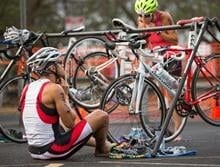
Get familiar with the transition area and be sure your gear is set up efficiently. This will help ensure a quick transition between the first transition (T1) from swim to bike and the second transition (T2) from bike to run.
Your Location
- If you can choose your own spot, look for one at the end of a row and close to the exit. This is usually a good location for the bike exit.
- Make your spot visually distinctive—with a balloon, bandana, flag, ribbon or funky towel—so it's easy to find.
- Memorize your spot by walking from the water's edge to the T1 transition area. Take note of landmarks to help find your bike.
Set Up Your Gear for T1 and T2
- Space is limited. Bring only what is necessary.
- Lay your items on an open towel so you can stand on it and wipe your feet clean and dry while putting on your helmet.
- Open the straps on your cycling shoes.
- Clothing and socks don't go well onto wet bodies, so roll your socks down to the toes to put them on easier. Do the same with sleeves or other clothing you might put on.
- Set the socks in your shoes.
- Attach the race number to the bike frame, helmet and the clothing you'll be wearing for the bike and/or run. Don't fold or cut it—you could get a penalty.
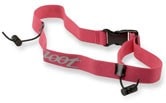
Tip: Use a race belt to attach race numbers. It's quick to put on and good for both the bike and run (plus, no safety pins). Wear it so the number is visible in back for the bike, and then rotate it to the front for the run.
- Place your helmet with straps out and upside down on the aero bars.
- Put your sunglasses into the helmet with arms open so you can put the glasses on first, then the helmet.
- Have a water bottle for rinsing your feet after the swim; you may want some sips during the transition, too.
- If using a hydration belt, have the bottles filled and any energy food loaded.
- If the weather if questionable, cover the gear with plastic.
Tip: Use a 5-gallon bucket as your transition bag—you can turn it upside down and use it as a stool for changing shoes.
Setting Up the Bike
- Check for correct tire pressure using a floor pump.
- Ensure the brake-release lever (which may be loosened to take a tire off) is set and not open.
- If using a speed and distance monitor with an accelerometer as a sensor, be sure it's attached properly to the bike hub.
- Make sure the handlebar has end caps—you can get disqualified at an Ironman if they don't.
- Make sure your bike is racked so it comes off easily. If you can rack your bike so the front is pointed out, do so. It allows quicker exits and better visibility.
- If using gloves, attach them to the handlebar with their hook-and-loop straps.
- Make sure water bottles are filled with water or a nutrition drink and pull the spout open so it's ready to use.
- If using a bike computer, makes sure it's reset and ready to go.
- Put the bike in a low gear for starting out.
- With small pieces of duct tape (or other adhesive), tape your energy gels to the tube of your bike in layers. Then you can rip one off and open it at the same time.
Tip: If using an aero-style bottle, be careful with energy drinks. Your bike can turn it into a sticky mess as it's jostled while cycling.
Extras
- An indelible marker (for writing your race number on your arm and leg).
- A few band-aids and a travel-size antiseptic.
- Waterproof sunscreen with an SPF of 30 or more (use SPF 50 if you're sun sensitive).
- Lip balm.
- Tape for putting race number on bike.
- Duct tape—it can always come in handy.
- Safety pins for your number if you don't use a race belt.
- Toilet paper—with lots of people using portable toilets, the toilet paper tends to run out.
- Timing chip—races provide one and a strap, but some people buy their own or at least have their own timing chip strap.
Preparing Yourself
- Put the timing chip on your left leg—on the right leg it could catch on the bike gears.
- Have your watch or fitness monitor ready to go.
- If using a speed and distance monitor with a foot pod, attach it securely to your running shoe.
- Stay warm and hydrated.
- Transition areas can get hectic during a race so make sure you know the flow of swim in, bike out, bike in and run out.
- Try walking the transitions before the race starts.
- If you have time for a warm-up, do it in reverse—run, bike and then swim.
- Put on the goggles and adjust them to fit.
- If it's allowed, get in the water 10 minutes before you start to warm up and get used to the water.
Swim Gear Tips
Wetsuits
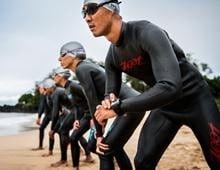
A wetsuit makes you more buoyant and saves you time overall, even though it does take some time to take one off. Wetsuits are allowed and optional in water temperatures of 84°F or colder, but in higher water temperatures the USA Triathlon's (USAT) governing board prohibits them.
If you are a minimalist or if the water temperature is above 84°F, the only necessity is a swimsuit. In Ironman races and USAT sanctioned races, you'll need a USAT-approved wetsuit. See a complete list of approved wetsuit models.
Before putting on a wetsuit:
- Allow plenty of time to get into the wetsuit and zip it up.
- Lube yourself generously, applying from elbows to wrist, from knees to ankles and on the feet. Put some on the back of your neck to avoid rubbing burns.
- Use lubes designed for triathletes. Regular petroleum jelly can degrade wetsuit material.
Putting it on:
- Unzip the wetsuit.
- Fold it down at the waist.
- Slide a foot through 1 leg of the wetsuit, and then your other foot through the other leg.
- Pull as much excess up as possible, pulling from the inside out.
- Next, pull the wetsuit up around your waist and bring it up toward your neck.
- Put a hand through 1 sleeve and then the other hand through the other sleeve, pulling up to the shoulders.
- Reach behind, hold the zipper base with 1 hand and pull the zipper leash up with the other hand. If it's a down zips, get someone to help you.
- Tuck the ankle strap and timing chip under your wetsuit leg cuff.
- Make sure the sleeve is over your wristwatch/fitness monitor.
- Position the leash so it stays out of your way during the swim.
- If you're going to carry gel during the swim, stash it in a cuff or sleeve.
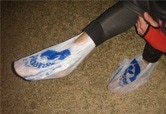
Tip: When putting on your wetsuit, put a plastic bag on each foot to make the wetsuit slide on easier. It looks funky but saves time. You can do the same with your hands.
Goggles
- It's best to have 2 pairs of goggles—a clear pair for darker conditions and a tinted pair for sunny days. It's also good to have a second pair on hand just in case a strap breaks.
- Make sure they are sized correctly. The straps and lenses should be comfortable yet snug enough to keep water out.
- To avoid getting goggles knocked off your head, put the straps under the cap.
- Alternatively, use a swim mask instead of goggles for maximum visibility and comfort.
Swim Caps
- If the cap is supplied by the race, try it on beforehand.
- Have an extra cap. They rip easily.
- For more warmth, wear 2 swim caps. Just make sure the official race cap is on the outside.
If you're bald or shave your head, a cap will go on easily. Otherwise:
- Flatten short hair down. Put long hair into a ponytail.
- Put your hands in the cap and spread it open as far as you can.
- Pull the back of the cap over the back of your head and pull the front to your forehead while pulling down at the same time.
- Pull it down overall and tuck into the cap any short ends of hair that are sticking out.
Extras
- Earplugs.
- Nose plug.
Swimming Tips
Getting Ready
- Survey the swim course. Will it go clockwise or counter-clockwise? Will the turn be left or right? Are there multiple buoys?
- If there are 2 races, make sure you know which buoy is your target.
- Try to gauge the sun angle and wear the appropriate goggle tint.
- Look for landmarks around the buoys—trees, a large house, a dock, flags, etc. —to know where you are during the swim.
Etiquette
- Position yourself accordingly. If you're a strong swimmer, be in the front. If you are a beginner, stay to the side or behind faster swimmers.
- Respect others' space as much as you can.
Starting
- If starting waist deep, dive forward, give a powerful kick and transition into the strokes.
- If it's a beach start, run to the water, dive in, use the ground to pull forward and then start stroking.
During

- There is no way to avoid contact in the swim. Arms are flapping and feet are kicking, and someone may swim over you. Know it's going to happen, be prepared and don't panic. Stay calm and keep swimming.
- Keep an eye on where you're going so you don't do any extra swimming.
- To stay on course in poor visibility, stay close to the feet ahead of you (try not to hit them).
- If your goggles come off, roll on your back, get them seated, roll back over and keep swimming. Keeping the body in the flat position is easier and faster than treading water.
- When everyone moves in on a turn, it's a big traffic jam. Be on the outside of the turn where there is less traffic and then work in as you go to the buoy. You'll be less frustrated and may not need to break your stroke.
- If you get tired and need a rest, find a lifeguard's vessel, hang on and take a breather.
Tip: You're going to get punched and kicked—don't take it personally. You might do it to someone, too.
Leaving the Water
- About 50 meters from shore, stop kicking from the hip and start bending your knees. Use your quads and hamstrings to prepare your legs for cycling.
- When coming into shore, swim as far as you can. Once your fingers touch the ground, use it to pull yourself in farther. It's easier and faster to glide in the water then run in waist-high water.
- Once you hit the shore, leave goggles and cap on and start unzipping the wetsuit as you move to the transition area.
T1 Tips: Swim to Bike
Hopefully, you have checked out the swim-finish-to-transition area prior to the race. If so, you'll know how far it is to the transition area and type of surface. If it's a rough surface, you may want flip-flops off to the side and ready to grab.
Removing the Wetsuit
- Cross your arms, grab the zipper tracks and pull the shoulders downward.
- Take off and hold your goggles and swim cap with your left hand.
- Use your right hand to hold the left zipper track and pull the left arm out of the sleeve while leaving the goggles and cap secured in the sleeve.
- Then use your left hand to hold the right zipper track and pull the right arm out of the sleeve.
- The suit will then be hanging down from your waist.
- To get your legs out, push both your thumbs under one of the suit's legs and slide it down over your ankle. Step on the leg while taking it off to help pull. Do it again with the other leg.
For most races, time is of the essence and athletes use a swim or triathlon suit for the entire race. In Ironman and some other long races where comfort is more important, there are changing tents for a complete clothing change.
Preparing for the Bike
- The gear on your towel should all be sitting in the order you need it.
- As you've been stripping off the wetsuit, you should be standing on the towel and wiping your feet. Make sure they are as clean as possible. Use a water bottle to rinse off any debris before putting on socks and/or shoes.
- If you need more lubricant, put it on now.
- Take your previously rolled-up socks out of the shoes and roll them on your feet.
- Put socks and shoes on one foot at a time. If you have that 5-gallon bucket, now is when you can use it as a stool.
Leaving T1
- Put your sunglasses on first, then the helmet. This way they will be under the helmet straps and won't get knocked off when you pull your helmet off in T2.
- Make sure your helmet strap is buckled before getting on the bike so you don't get disqualified.
- Make sure you pass the mounting line before getting on your bike.
- Your bike should be in a lower gear so it is easier to pedal when you start out.
- If you're using gloves, put them on once you're pedaling and out of the transition area.
Tip: Use a saddle with gel or a gel seat cover for more comfort (especially if you wear swim shorts during the bike phase).
Bicycling Tips
Etiquette
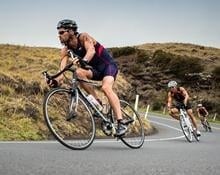
- If you're riding with other cyclists, remember to stay to the right until you want to pass.
- Warn "on you left" when you are about to pass, then pass quickly and get in front of that cyclist.
- When being passed, stay to the right and let the cyclist pass you.
- If on trails, passing is more difficult and risky. Remember, safety first.
- Have fun, wave, smile and cheer for people.
- Thank your volunteers.
Nutrition and Hydration
- Be sure to hydrate while you are cycling. Water is good, but an energy drink that replenishes carbohydrates and electrolytes is even better.
- Keep 2 water bottles accessible in holders.
- If you know ahead of time what type of energy drink will be provided at aid stations, practice with that beverage during your training so you are used to it on race day.
- Especially for longer rides, you'll want nutrition that is easily accessible.
On the Course
- Ride single file except when passing.
- Don't draft behind other riders.
- Be prepared. Make sure you have a spare tube, CO2 cartridges or a pump
- Watch the road. Besides the normal road hazards, watch for water bottles that may accidentally have been dropped.
- Know the location of aid stations.
- Do some shoulder shrugs occasionally to relax your shoulders.
Finishing the Ride
- When nearing the transition, downshift, up your cadence and start spinning to loosen up your legs for the run.
- When coming in to T2, slow down and release shoe buckles to slip out of your bike shoes faster.
- Know the location of the dismount line.
- Remember where to park your bike in the transition area.
- Know the exit location.
T2 Tips: Bike to Run
- Reapply sunscreen if appropriate.
- Again, if you have a 5-gallon bucket, use it as a stool.
- Grab your hat and sunglasses (if wearing different ones for the run).
- If you're doing an Olympic or Ironman distance, use a hydration belt. It'll keep snacks and fluids available when you want them, and then you can fuel up again at aid stations.
Running Tips

- Try to relax and settle into a pace.
- Keep hydrating as you go.
- Stay focused. You have two-thirds of the race done!
- Try doing a negative split run—start slower and get faster as the distance increases and as you loosen up from the ride.
- Watch for traffic.
- Smile and prepare yourself for the finish line picture!
Etiquette
- At this point, everyone is tired and needs encouragement. Pass on the left; stay to the right if going slower.
- If using the portable toilets, try to keep the line moving as fast as possible.
- When using the aid stations, go to the middle or end instead of the beginning to help control congestion.
- Throw trash away in the receptacles.
- Thank your volunteers.
- Keep moving up the finish chute; there are others behind you.
Post-race Tips

- Get your finisher's shirt and keep hydrating.
- Keep walking to avoid cramping.
- Refuel with a protein-rich food in the first 30 to 45 minutes of finishing.
- On shorter races, do a cool down and some light stretching.
- Get out of your running shoes, put on something comfortable and give your feet a rest.
- Enjoy the finish line festivities.
- If it's allowed, have someone else pack up your gear while you're out on the run. Otherwise, pack up your own gear and take it home.
- The next day, go spin on the bike, walk around, swim, relax or get a massage—it all depends on the race distance, intensity and how you are feeling.
- Give yourself a pat on the back and relish your accomplishment!
Avoiding Common Violations
You've worked hard and do not want to get penalized or disqualified from your race. Know your race rules.
| Most Commonly Violated Triathlon Rules | ||
|---|---|---|
| Topic | USAT Rule | Penalty |
| Helmets | Only helmets approved by the U.S. Consumer Product Safety Commission (CPSC) may be used in USAT sanctioned events. Helmets must be worn at all times while on your bike. | Disqualification |
| Chin straps | Chinstraps must be buckled at all times when on a bicycle. | Disqualification on course; variable time penalty in transition area |
| Outside assistance | No assistance other than that offered by race and medical officials may be used. | Variable time penalty |
| Transition area | All equipment must be in the assigned bike corral. | Variable time penalty |
| The wheel of the bicycle must be down on the side of the assigned space. | Variable time penalty | |
| Bicycles must be returned to an upright position in assigned space. | Variable time penalty | |
| No person shall interfere with another participant's equipment or impede the progress of another participant. | Variable time penalty | |
| All bar ends must be solidly plugged. | Variable time penalty | |
| No glass containers are allowed in the transition area. | Variable time penalty | |
| Bicycling | Drafting: At least 3 bike lengths space between you and the cyclist in front. Once in the zone, pass within 15 seconds. | Variable time penalty |
| Position: Stay on the right unless passing. | Variable time penalty | |
| Blocking: Riding on the left side of the lane without passing anyone and interfering with other cyclists attempting to pass. | Variable time penalty | |
| Overtaken: Once passed, you must immediately exit the draft zone from the rear before attempting to pass again. | Variable time penalty | |
| Bicycling course | Follow the course and stay within coned lanes | Referee's discretion |
| Crossing a solid yellow center line is not allowed. | Referee's discretion | |
| All traffic rules must be obeyed. | Referee's discretion | |
| Conduct | Foul, harsh, argumentative or abusive language or other unsportsmanlike conduct is not allowed. | Disqualification |
| Headphones | Headphones, headsets, walkmans, iPods, MP3 players or personal audio devices are not to be carried or worn at any time during the race. | Variable time penalty |
| Race number | Must be worn at all times, not folded, cut or altered. | Variable time penalty |
| Do not transfer your number to another athlete or take a number from an athlete who is not competing. | Disqualification and 1 year suspension | |
| Abandonment | Personal equipment and belongings taken onto the course must stay with the athlete the entire time. Nothing can be thrown to the side of the road. | Variable time penalty |
See the complete list of USAT Competitive Rules.
